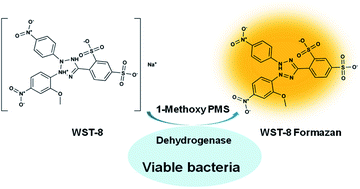A simple colorimetric method for viable bacteria detection based on cell counting Kit-8
Abstract
In this study, Cell Counting Kit-8 (CCK-8) was introduced to detect the concentration of live bacteria for the first time depending on the redox reaction between CCK-8 solution and dehydrogenase. CCK-8 solution can be reduced to form water soluble orange-yellow formazan by the dehydrogenase present in bacterial cells, and the concentration of live bacteria is proportional to the absorbance value of formazan at 450 nm. Based on this principle, Staphylococcus aureus and Escherichia coli were chosen as the model bacteria. The optimal detection conditions were investigated and a good linear relationship was obtained in the concentration range from 2.600 × 102 to 1.160 × 109 CFU mL−1 with a linear equation of Y = 0.06305 log10 X-0.1153 (X in CFU mL−1, R2 = 0.9747) for S. aureus and 9.750 × 102 to 6.000 × 108 CFU mL−1 with a linear equation of Y = 0.06122 log10 X-0.1358 (X in CFU mL−1, R2 = 0.9958) for E. coli. The CCK-8 based viable bacteria detection method can be completed within 2 h with a wide bacterial detection concentration range. Satisfactory results were obtained when applied to an actual sample analysis and there is a good consistency between the proposed CCK-8 based method and the traditional plate counting method. More importantly, this method can realize the one-time detection of a large number of samples with high sensitivity, which suggests its great potential in high-throughput bacterial detection.



 Please wait while we load your content...
Please wait while we load your content...